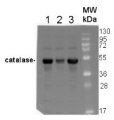1

Anti-HRP | Horseradish peroxidase
AS16 3951 | Clonality: Polyclonal | Host: Rabbit | Reactivity: A. rusticana, A. thaliana, C. elegans
- Data sheet
-
- Product Info
-
Immunogen: Native peroxidase isolated and purified from horseradish. Host: Rabbit Clonality: Polyclonal Purity: Serum Format: Lyophilized Quantity: 50 µl Reconstitution: For reconstitution add 50 µl of sterile destilled water Storage: Store lyophilized/reconstituted at -20°C; once reconstituted make aliquots to avoid repeated freeze-thaw cycles. Please remember to spin the tubes briefly prior to opening them to avoid any losses that might occur from material adhering to the cap or sides of the tube. Tested applications: ELISA (ELISA), Western blot (WB) Recommended dilution: 1 : 1000-1 : 5000 (WB) Expected | apparent MW: 38.6 kDa - Reactivity
-
Confirmed reactivity: Armoracia rusticana, Arabidopsis thaliana, Caenorhabditis elegans Predicted reactivity:
Species of your interest not listed? Contact usNot reactive in: No confirmed exceptions from predicted reactivity are currently known - Application Examples
- Application example
 Proteins were isolated from poplar T89, barley, Arabidopsis thaliana, horseradish root mutants were solubilized with 3X LB (6 M urea, 12% SDS, 30% glycerol, 100 mM DTT, 150 mM Tris pH7.0, 0.8% Comassie G-250). 45 µg of total proteins and 45-7.5 µg of HRP were loaded into each lane and separated on 12% SDS-PAGE, and then blotted overnight onto PVDF membrane. Membranes were blocked with milk powder for 2 h and then incubated in the primary antibody solution overnight, which was then decanted and the membrane was washed 3 times for 5 min in TBST. Membrane was incubated at RT for 1 hour in 1:10 000 goat anti-Rabbit secondary antibody AS09 602, followed by washing steps as above. Membrane was developed for 2 min with chemiluminescent detection reagent according to the manufacturer’s instructions and recorded using FujiFilm CCD camera with 10 s increment time for around 100 s.
Proteins were isolated from poplar T89, barley, Arabidopsis thaliana, horseradish root mutants were solubilized with 3X LB (6 M urea, 12% SDS, 30% glycerol, 100 mM DTT, 150 mM Tris pH7.0, 0.8% Comassie G-250). 45 µg of total proteins and 45-7.5 µg of HRP were loaded into each lane and separated on 12% SDS-PAGE, and then blotted overnight onto PVDF membrane. Membranes were blocked with milk powder for 2 h and then incubated in the primary antibody solution overnight, which was then decanted and the membrane was washed 3 times for 5 min in TBST. Membrane was incubated at RT for 1 hour in 1:10 000 goat anti-Rabbit secondary antibody AS09 602, followed by washing steps as above. Membrane was developed for 2 min with chemiluminescent detection reagent according to the manufacturer’s instructions and recorded using FujiFilm CCD camera with 10 s increment time for around 100 s. - Background
-
Background: Horseradish peroxidase (HRP) is a secretory plant peroxidase that catalyzes the oxidation of small aromatic substrates, such as plant hormone and lignin precursors by hydrogen peroxide, acts in oxidation of toxic reductants, biosynthesis and degradation of lignin, response to environmental stresses such as wounding, pathogen attack and oxidative stress.
- Protocols
- Reviews:
-
Anna P | 2019-04-17Western Blotting of HRP was performed in protein extracts from Arabidopsis thaliana leaves. Cell wall proteins or apoplastic washing fluids were isolated and respectively 30 ug or 10 ug protein was separated in 12% acrylamide SDS gel. Primary antibodies were diluted at 1:5000 and secondary antibodies were diluted at 1:10000. A band for HRP could be recognized at around 40 kDa in both extracts, However there were many bands visualized which makes the identification of the specific HRP proteins difficult.
Accessories

AS09 501 | Clonality: Polyclonal | Host: Rabbit | Reactivity: A.thaliana, A.madagascariensis, B. distachyon, B.oleracea, Cirtus sp., Fragaria x ananassa, H.vulgare, L. sativus, L. albus, M. perniciosa, N.bentamina, N.tabacum, O.sativa, P. kurroa, P.sativum, P. zeylandica, P.tomentosa, S. italica, S.lycopersicum, S.oleracea, T.aestivum, Z.mays, V. vinifera
Benefits of using this antibody


